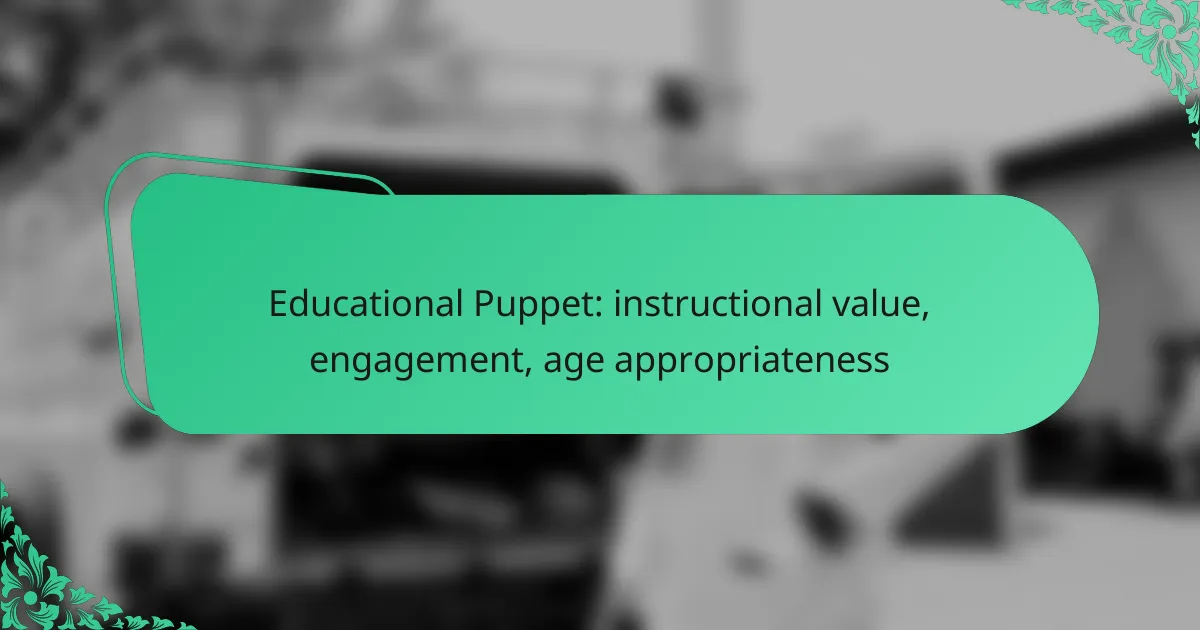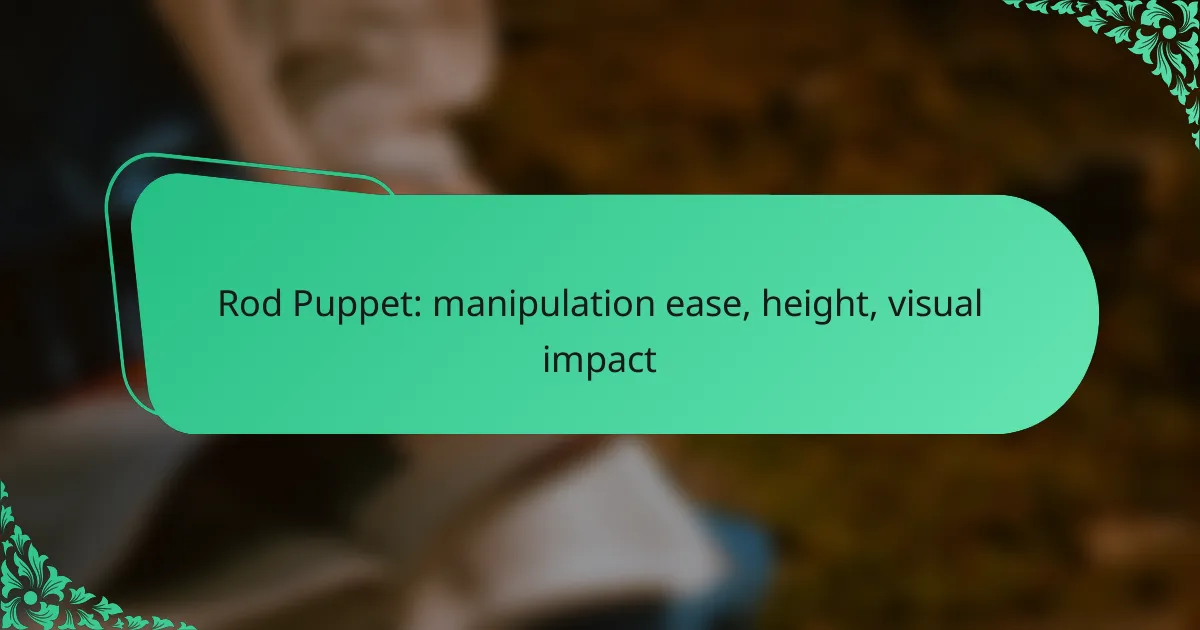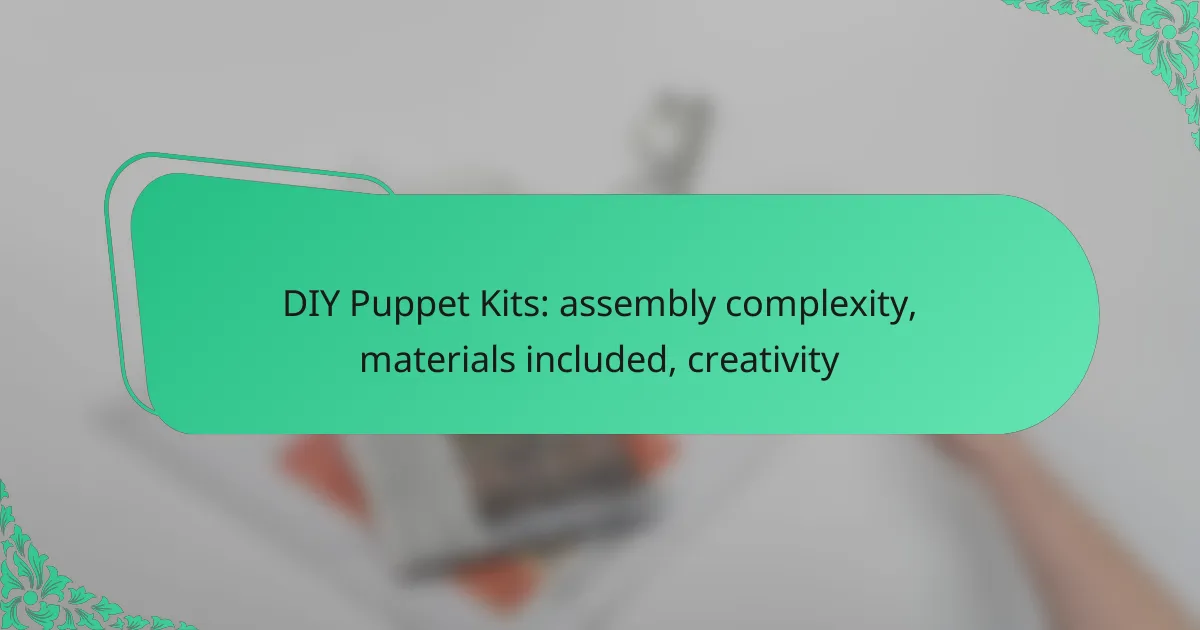Educational puppets play a crucial role in enhancing learning experiences by making lessons more engaging and interactive for children. They are particularly effective across various age groups, promoting cognitive and emotional development while simplifying complex concepts. By fostering creativity and encouraging participation, these puppets serve as valuable tools in educational settings.
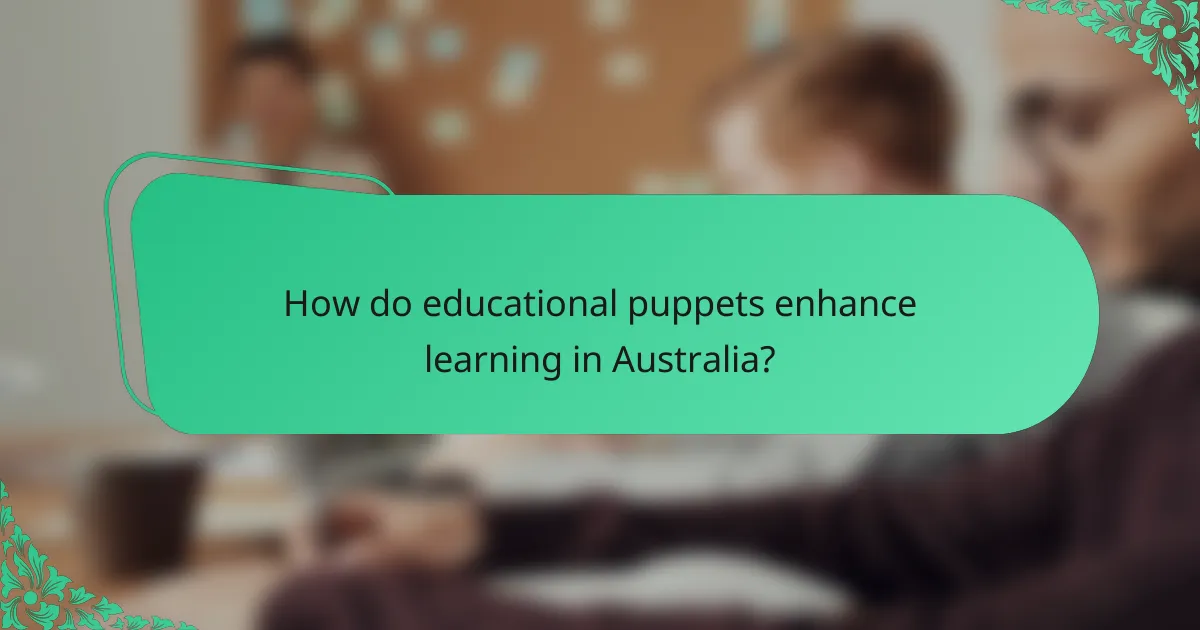
How do educational puppets enhance learning in Australia?
Educational puppets significantly enhance learning in Australia by making lessons more engaging and interactive for children. They serve as effective tools for teaching various subjects while catering to different age groups, promoting both cognitive and emotional development.
Interactive storytelling
Interactive storytelling with puppets captivates children’s attention and encourages participation. By incorporating puppets into narratives, educators can create immersive experiences that allow students to engage with the material actively. This method helps children understand complex concepts through relatable characters and scenarios.
For example, a puppet can act out historical events or scientific processes, making them more accessible and memorable. This approach not only aids comprehension but also fosters a love for storytelling and learning.
Visual and auditory engagement
Puppets provide both visual and auditory stimulation, which is crucial for effective learning. The colorful designs and expressive movements of puppets capture children’s interest, while their voices can convey emotions and tone, enhancing the learning experience. This multi-sensory approach caters to various learning styles, ensuring that more children benefit from the lessons.
In classrooms, using puppets to present information can help maintain focus and reduce distractions, making it easier for students to absorb knowledge. Teachers can also encourage students to create their own puppet shows, further reinforcing the material learned.
Development of social skills
Using educational puppets helps children develop essential social skills, such as communication, empathy, and teamwork. When children interact with puppets, they practice expressing their thoughts and feelings in a safe environment. This interaction can lead to improved verbal skills and confidence in speaking.
Group activities involving puppets encourage collaboration, as children work together to create stories or performances. This teamwork fosters a sense of community and helps children learn how to navigate social dynamics effectively.
Encouragement of creativity
Puppets inspire creativity by allowing children to explore their imaginations. When students create their own puppets or develop stories, they engage in creative thinking and problem-solving. This process not only enhances their artistic abilities but also encourages them to express their unique perspectives.
Incorporating puppet-making activities into the curriculum can be a fun way to stimulate creativity. Teachers can provide materials for students to design their puppets, which can then be used in storytelling sessions, further enriching the learning experience.

What age groups benefit from educational puppets?
Educational puppets are effective tools for various age groups, particularly young children and those in special needs education. They enhance learning through engagement and interaction, making complex concepts more accessible and enjoyable.
Preschool children
Preschool children, typically aged 3 to 5, greatly benefit from educational puppets as they stimulate imagination and creativity. Puppets can help teach basic concepts such as numbers, letters, and social skills through playful storytelling and role-playing.
Using puppets in this age group encourages language development and emotional expression. Simple puppet shows can illustrate everyday scenarios, helping children understand feelings and social interactions.
Primary school students
Primary school students, aged 6 to 12, can also gain from educational puppets by enhancing their understanding of more complex subjects. Puppets can be used to introduce topics in science, history, and literature, making lessons more relatable and engaging.
In this age group, puppets can foster teamwork and communication skills during group activities. Students can create their own puppet characters to present projects, encouraging creativity and collaboration.
Special needs education
Educational puppets are particularly valuable in special needs education, as they can cater to diverse learning styles and needs. Puppets can facilitate communication for non-verbal students and help them express emotions in a safe environment.
Using puppets can also create a calming atmosphere, reducing anxiety during learning activities. Incorporating visual and tactile elements through puppetry can enhance focus and retention for students with attention difficulties.
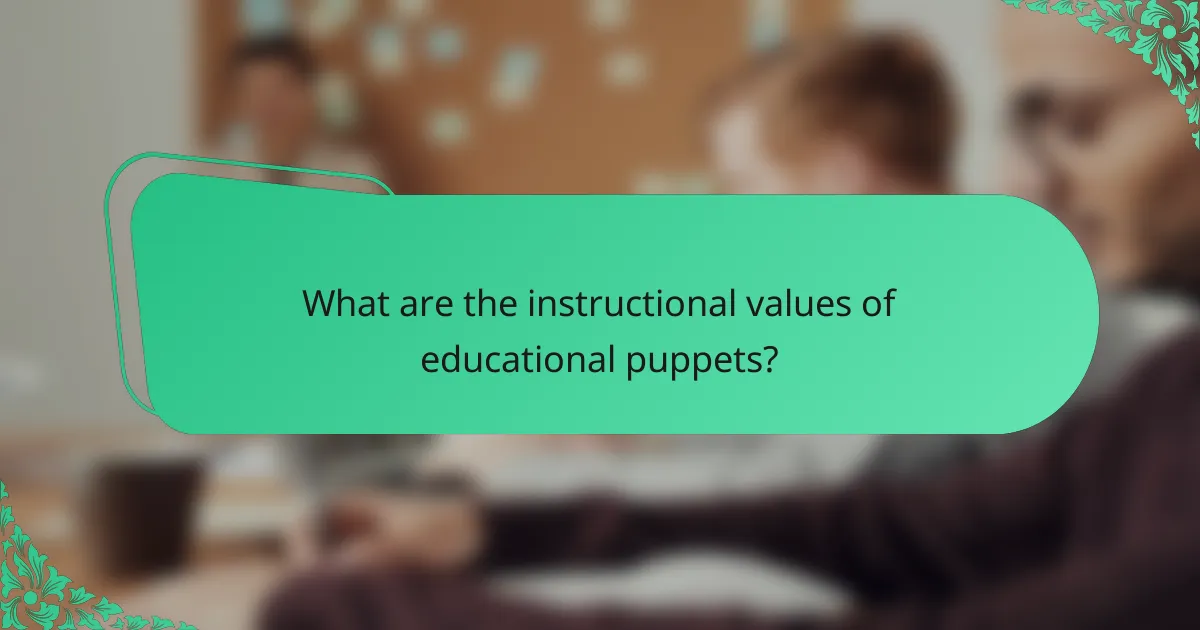
What are the instructional values of educational puppets?
Educational puppets serve as powerful tools in teaching by enhancing engagement and facilitating learning across various subjects. They can foster creativity, encourage participation, and support the development of essential skills in children.
Promotes critical thinking
Educational puppets encourage children to think critically by prompting them to ask questions and solve problems during interactive play. When puppets present challenges or dilemmas, children are invited to explore different solutions, enhancing their analytical skills.
For example, a puppet might face a decision that requires weighing pros and cons, allowing children to discuss and debate the best course of action. This process helps develop reasoning abilities and encourages children to articulate their thoughts clearly.
Enhances language skills
Puppets can significantly boost language development by providing a fun and engaging way for children to practice speaking and listening. Through role-play and dialogue with puppets, children expand their vocabulary and improve their conversational skills.
Using puppets in storytelling or group activities can help children learn new words in context, making it easier to remember and use them. Additionally, puppets can model proper pronunciation and grammar, reinforcing language concepts in an enjoyable manner.
Facilitates emotional expression
Educational puppets provide a safe outlet for children to express their feelings and emotions. By interacting with puppets, children can explore complex emotions such as fear, joy, or sadness without the pressure of real-life consequences.
For instance, a child might use a puppet to act out a situation that makes them anxious, allowing them to process their feelings and develop coping strategies. This practice can enhance emotional intelligence and foster empathy as children learn to understand and relate to the emotions of others.
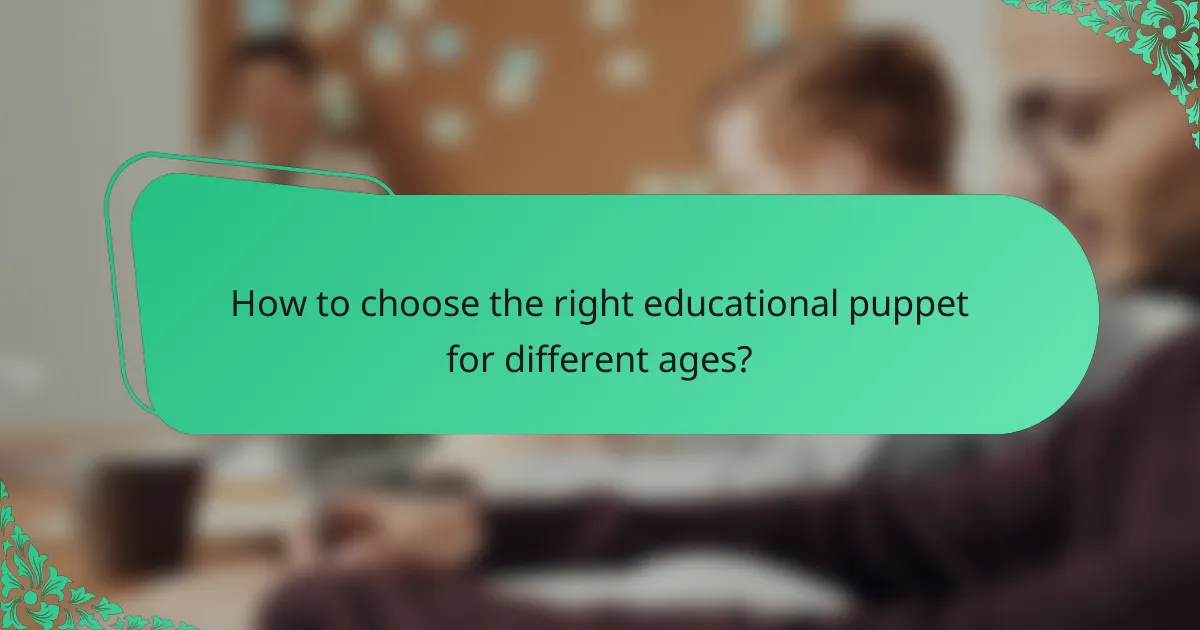
How to choose the right educational puppet for different ages?
Selecting the appropriate educational puppet for various age groups involves considering material safety, complexity, and thematic relevance to the curriculum. Tailoring your choice to the developmental stage of the children ensures both engagement and effective learning.
Material safety for young children
When choosing puppets for young children, prioritize materials that are non-toxic and free from small parts that could pose choking hazards. Look for puppets made from soft fabrics and compliant with safety standards such as ASTM or EN71.
Additionally, consider puppets that are machine washable or easy to clean, as hygiene is crucial for younger audiences. Avoid puppets with sharp edges or small accessories that can easily detach.
Complexity for older students
For older students, puppets can be more complex in design and functionality, allowing for deeper engagement. Consider puppets that incorporate mechanisms for movement or sound, which can enhance storytelling and educational activities.
Older children may benefit from puppets that encourage creative expression, such as those that can be customized or modified. This complexity can foster critical thinking and problem-solving skills during interactive sessions.
Theme relevance to curriculum
Select puppets that align with the educational themes being taught in the classroom. For instance, if the curriculum focuses on environmental science, choose puppets that represent animals or ecosystems relevant to that subject.
Using puppets that reflect the curriculum not only enhances engagement but also reinforces learning objectives. Consider integrating puppets into lessons on history, literature, or social skills to create a more immersive educational experience.
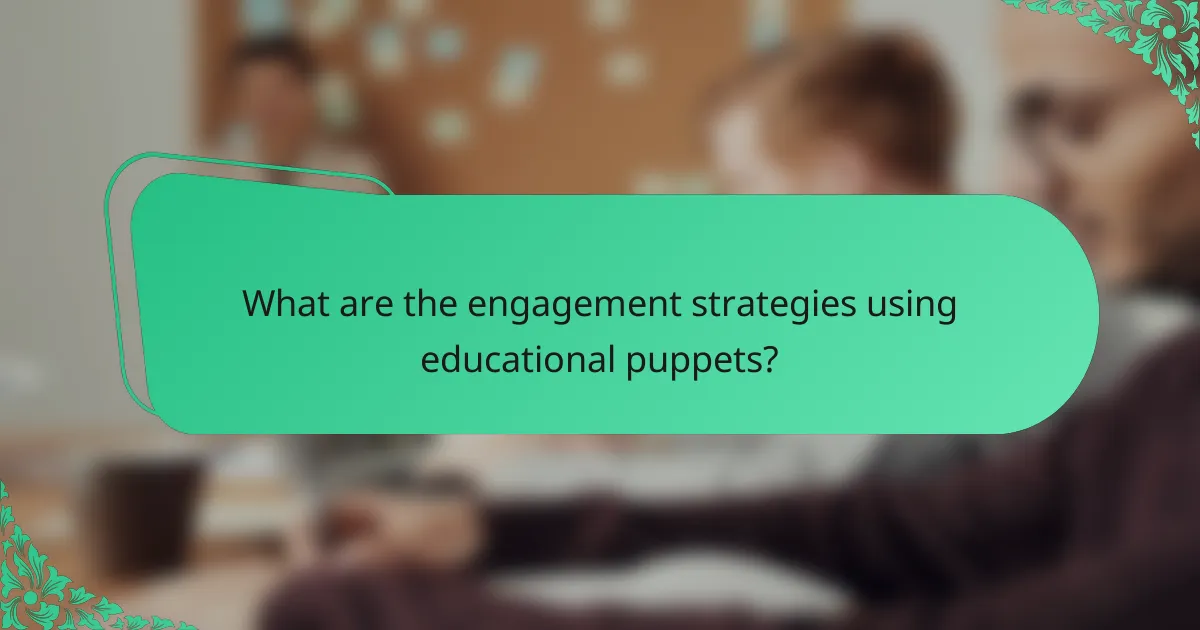
What are the engagement strategies using educational puppets?
Engagement strategies using educational puppets involve interactive methods that capture children’s attention and enhance learning. These strategies leverage role-playing, group activities, and technology to create immersive educational experiences.
Role-playing scenarios
Role-playing scenarios allow children to embody different characters, fostering creativity and empathy. By using puppets to act out stories or real-life situations, educators can facilitate discussions about emotions, problem-solving, and social interactions.
To implement role-playing, select relatable themes that resonate with the age group, such as friendship or conflict resolution. Encourage children to express their thoughts and feelings through the puppets, which can help them articulate complex ideas in a safe environment.
Group activities and performances
Group activities and performances promote teamwork and communication skills among children. By collaborating on puppet shows or skits, students learn to share ideas, negotiate roles, and support one another, enhancing their social skills.
Consider organizing small groups to create short performances based on a lesson theme. This approach not only reinforces the educational content but also allows children to practice public speaking and presentation skills in a fun and engaging manner.
Incorporating technology
Incorporating technology into puppet-based activities can elevate engagement and learning outcomes. Tools such as video recording, animation software, or interactive apps can enhance traditional puppet shows, making them more dynamic and appealing to tech-savvy learners.
For instance, educators can use video editing software to create a digital puppet show that can be shared with parents or peers. This not only showcases the children’s creativity but also integrates digital literacy skills into the learning process.
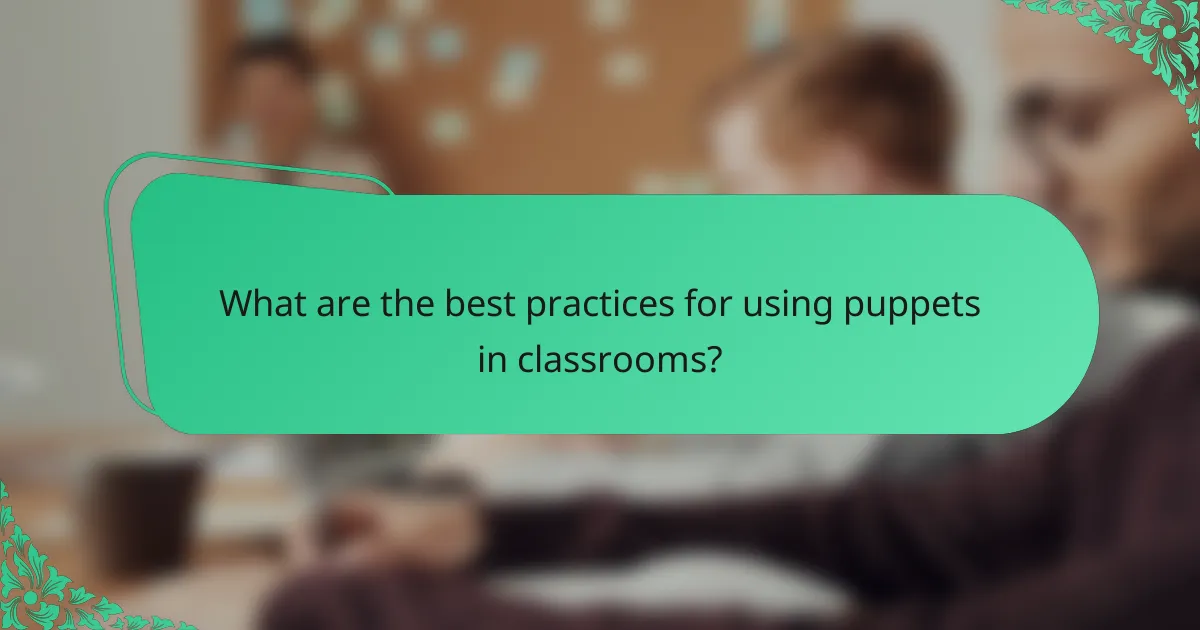
What are the best practices for using puppets in classrooms?
Effective use of puppets in classrooms enhances instructional value and engagement among students. Best practices include integrating puppets thoughtfully into lesson plans and fostering active participation from learners.
Integrating with lesson plans
When incorporating puppets into lesson plans, align their use with educational objectives. For instance, puppets can illustrate complex concepts in subjects like science or literature, making them more relatable and easier to understand.
Consider using puppets to introduce new topics, summarize lessons, or role-play scenarios. This approach not only captures students’ attention but also reinforces learning through visual and interactive means.
Encouraging student participation
Puppets can significantly boost student engagement by encouraging participation. Allow students to manipulate the puppets during discussions or presentations, which can help build confidence and communication skills.
To maximize participation, create opportunities for students to develop their own puppet characters related to the lesson. This can lead to collaborative projects where students work together, enhancing both social skills and teamwork.






